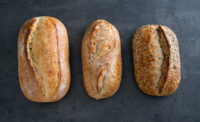The fresh bread category remains the most important segment in bakery today. It’s highly competitive, and the playing field continues to grow more crowded as more product dynamics like artisan and better-for-you come into consideration with increased frequency.
Overview | Bread | Tortillas | Sweet Goods | Snack Cakes | Pizza | Desserts | Cookies | Buns & Rolls | Bars | Breakfast Products
Nevertheless, the overall category remains flat. But pockets of accelerated activity point to significant opportunities for incremental growth—especially when someone like Oprah Winfrey sings the praises of bread, as we witnessed at the beginning of this year when she proclaimed her love of “the grainiest, nuttiest, seed bread” that she can find.
Market data
According to IRI, Chicago, the fresh bread and rolls category accounted for $13.3 billion in sales for the 52 weeks ending April 17, 2016, increasing 0.86 percent in dollar sales. The fresh bread segment was likewise flat, up just 0.47 percent in dollar sales to $9.1 billion.
United States Bakery, better known as Franz Family Bakery, saw dollar sales rise 7.91 percent to $150.48 million. Aunt Millie’s Bakeries also saw above-average dollar sales, up 3.04 percent, and Flowers Foods was up 2.54 percent.
But the true bright spot in fresh bread for the year was Dave’s Killer Bread, a brand that is now under the Flowers Foods umbrella. Dave’s Killer Bread, a better-for-you, organic line, was up 32.43 percent in dollar sales to $94.7 million.
Bagels accounted for $857.8 million for the year, down 1.17 percent in dollar sales. Grupo Bimbo, with its Thomas’ bagel brand, is the segment leader, posting a loss of 3.02 percent in dollar sales to $583.2 million. Private label, in the No. 2 slot, fared better, up 3.80 percent to $146.4 million. But two companies emerged as the sales-gain leaders in bagels for the year, with United States Bakery/Franz up 30.32 percent in dollar sales to $19.5 million, and Maple Leaf Bakery up 16.88 percent to $4.7 million.
English muffins saw better overall sales performance for the 52-week period, up 3.87 in dollar sales to $737.8 million. Flowers Foods offers English muffins via its Nature’s Own, Barowsky’s Organic and Captain John Derst brands as was up 17.05 percent in dollar sales to $8.5 million. Food for Life Baking Co., known for its sprouted-grain products, was up 14.23 percent in dollar sales to $13.5 million. United States Bakery/Franz likewise saw growth in its English muffin dollar sales, up 13.24 percent to $13.4 million. All-natural and organic specialist Vermont Bread Co. saw dollar sales grow by 122.73 percent to $3.8 million.
Looking back
Nutrition-forward breads are on the rise. The top company in fresh bread, Grupo Bimbo—via its U.S. arm, Bimbo Bakeries USA—recently launched the new Extra Grainy line under its Arnold, Brownberry and Oroweat brands. It includes three products: 17 Grains & Seeds, Cracked Wheat & Oats and Flax & Sesame Seeds. It complements the Healthfull line, another recent Bimbo Bakeries launch across its Arnold, Brownberry and Oroweat brands, consisting of Flax & Sunflower, Nuts & Seeds and Steel Cut Oats & Honey. Each slice is 80 calories, a message clearly indicated on product packaging. Both the Extra Seedy and Healthfull lines feature a high degree of exterior seed and/or whole-grain application, providing a strong visual impact.
And then there’s Dave. The acquisition of Dave’s Killer Bread by Flowers Foods last year was big news—and serves as a strong barometric reading for the future of better-for-you bread. Through its national distribution network and supply-chain efficiencies, Flowers Foods will now bring this former regional Northwest favorite to a national audience. The products are organic, non-GMO, loaded with better-for-you ingredients like whole grains and seeds, and are made without nuts, soy, dairy, high-fructose corn syrup or artificial preservatives. The business supports organic and sustainable agriculture and has a high degree of social consciousness. This combination of ingredients, formulation ethos and corporate conscience aligns very nicely with a prevailing national shopper demographic poised to reinvigorate its love affair with bread.
“People want to know more about their food sources and want GMOs, antibiotics, pesticides and other additives out of their food,” says David Sheluga, director, consumer insights, Ardent Mills, Denver. He also notes that people generally want to know more about their food. “They shop at organic and natural food stores, farmers’ markets and trendy grocery chains, and visit natural food restaurants featuring organic or vegetarian menus.” Fresh bread ingredients that fit here, he notes, include sprouted grains, ancient grains and organic flour. Many increasingly popular ancient grains are also gluten-free.
“I think we can get over the idea that gluten-free is just a fad,” says Ken Hagedorn, vice president of sales and partner, Naegele Inc., Sussex, NJ. “It is here to stay.” This is due to the large sector of people who don’t need to follow a gluten-free diet, but feel it’s healthier. He notes that equating gluten-free with health has served as a catalyst for bakers placing a greater emphasis on other health-oriented claims, like natural and whole-grain.
Bakeries have shown an inclination toward sourcing increasingly specialized ingredients. La Brea Bakery, an ARYZTA brand, recently entered the gluten-free breads market—and made waves with its introduction of a “farm-to-table” artisan bread line that features heirloom grains. The bakery notes that the line is the first single-origin heirloom grain artisan bread available on a national scale.
Sprouted grains are also finding more favor. Food for Life Baking saw a nice dollar sales increase for its English muffins over the past year. The company recently added Sprouted Grain Flax English Muffins to its Ezekiel 4:9 line. The products feature multiple sprouted ingredients: wheat, flax seeds, barley, millet, lentils, soybeans and spelt.
Sprouted products showed a 12.8 percent growth from 2011–2014, according to Nielsen Scantrack, says Sheluga, who sees a continued growth pattern in breads and other bakery products featuring sprouted grains.
Looking forward
As bakers search for defining points of differentiation to help products stand out in the competitive and crowded fresh breads category, suppliers will need to respond in kind to bring such products to market.
Dean Grossmann, vice president of sales, Ardent Mills, notes that close analysis of the supply and demand for organic flour supplies of the past year showed a growing demand from foodservice and retail CPG companies for organic wheat flour. “This is a significant opportunity for growers to become a part of an emerging market and to create additional value for their crops on the path to organic certification,” he says. “In late 2015, we announced an organic initiative committed to helping U.S. wheat growers double organic wheat acres by 2019.”
Sheluga notes that barley is poised to see further penetration into the fresh breads category. “I like to call this ‘the forgotten ancient grain,’” he says. “Barley is important to Nordic cuisines, which follows a current restaurant trend. This hearty grain was a staple among Vikings, but barley also dates to ancient Egypt and was important in early colonial times and American history.” He notes that the Sustagrain barley offered by Ardent Mills is a significantly less-expensive option compared to many other ancient grains and “works really well in baked breads and other bakery favorites.”
Ingredients like protein can also give an edge to highly nutritional breads. “Protein is important to consumers,” says Sheluga. “Plant protein consumption is rising, and claims like ‘helps with weight management’ and ‘sustained energy’ appeal to fitness buffs, vegetarians and people seeking meat alternatives. In the bread category, the combination of protein and fiber boosts sustained energy and can aid weight loss and weight management.”
Gluten-free will also continue to gain mainstream ground over the coming year, with greater penetration into more fresh bread segments. “I think once you see the taste of gluten-free products improve, prices come down and larger volumes by large baking companies entering the market, the market will grow even more,” says Hagedorn.
Finding new uses for bakery equipment can also yield innovative results. “I believe that showing bread manufacturers alternate ways of producing breads by nontraditional methods opens up a lot of doors,” says Hagedorn. “For example, breads have always been produced by dividers and rounders. Now more and more breads are being produced by dough sheeting methods, which offer more versatility on production lines—specifically in size and shapes. Also, the introduction of extruders—those normally used in the meat industry—are replacing the divider.”
Factor the rise of better-for-you ingredient innovation with creative equipment-based approaches to product formats and characteristics, and truly game-changing products could very well rise within the bakery industry to give the fresh bread category the long-awaited boost it very much deserves.
Overview | Bread | Tortillas | Sweet Goods | Snack Cakes | Pizza | Desserts | Cookies | Buns & Rolls | Bars | Breakfast Products


















